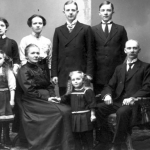How to Create a Family Tree: Getting Started
Embarking on the journey of tracing your family tree is like opening a door to a fascinating world filled with stories of your ancestors and the rich tapestry of your family’s history. Whether you’re a beginner or a seasoned genealogist, creating a family tree starts with a strong foundation. Here are essential steps to help you get started on this rewarding adventure.
- Begin with Yourself
The first and most crucial step is to start with what you know. Begin by documenting your own information, including your full name, birthdate, birthplace, and other vital details. This will serve as the anchor point from which you’ll trace your family’s roots.
- Gather Family Knowledge
Next, reach out to your immediate family members – parents, grandparents, aunts, uncles, and cousins. Interview them to gather as much information as possible about your family’s history. Record names, birthdates, marriages, and any significant life events they can recall. Don’t forget to ask about family traditions, anecdotes, and any historical documents or photos they may have.
- Organize Your Research
To keep your family tree research organized, consider using genealogy software or online platforms designed for this purpose. These tools allow you to input and organize data efficiently, making it easier to visualize your family tree as it grows. Popular options include Ancestry.com, MyHeritage, and FamilySearch.
- Collect Documents and Records
Begin searching for official records, such as birth certificates, marriage licenses, and death certificates for your family members. These documents often contain valuable information, such as parents’ names, dates, and places of birth. Visit local archives, libraries, and online databases to access these records.
- Collaborate with Relatives
Genealogy is often a collaborative effort. Share your research findings with relatives who may have different pieces of the puzzle. They might possess old family photos, letters, diaries, or heirlooms that can provide valuable insights into your family’s history.
- Create a Research Plan
As you uncover more information, it’s essential to create a research plan. This plan will help you stay focused and organized, preventing you from getting overwhelmed by the sheer volume of information available. Set specific goals and prioritize your research tasks.
- Explore Online Resources
The internet is a treasure trove of genealogical information. Explore online databases, forums, and websites dedicated to genealogy research. Websites like FindAGrave, Cyndi’s List, and the National Archives can be invaluable resources for your research.
- Join Genealogy Societies
Consider joining local or national genealogy societies. These organizations often offer access to exclusive resources, workshops, and seminars that can enhance your research skills and connect you with other genealogy enthusiasts.
Getting started on your family tree may seem daunting at first, but with patience, dedication, and a methodical approach, you’ll gradually unveil the hidden stories and connections that make up your family’s unique history. Building a solid foundation is the key to a successful and rewarding genealogy journey that can provide you and future generations with a deeper understanding of your roots and heritage.
Unearthing Historical Records: A Treasure Hunt for Ancestral Information
In the quest to trace your family tree, uncovering historical records is akin to embarking on a thrilling treasure hunt. These records hold the keys to unlocking the mysteries of your ancestors’ lives, and they can provide you with invaluable insights into your family’s past. Here, we’ll delve into the exciting world of genealogical research and explore the various types of historical records you can unearth on your journey.
- Vital Records
Vital records are an essential starting point for any genealogist. These official documents include birth certificates, marriage licenses, and death certificates. They often contain critical information such as names, dates, and places of significant life events. Vital records are typically held at government offices or archives, making them accessible sources of information about your ancestors.
- Census Records
Census records are a goldmine of genealogical information. Conducted regularly in many countries, these records provide a snapshot of the population at specific points in time. They include details like names, ages, occupations, and familial relationships. Census records can help you track your ancestors’ movements and family structures over the years.
- Immigration and Naturalization Records
For those with immigrant ancestors, immigration and naturalization records are a treasure trove. These documents can reveal the dates of arrival, ports of entry, and countries of origin of your immigrant forebears. Naturalization records can offer insights into the process of becoming a citizen and may include personal details like birthplaces and physical descriptions.
- Military Records
Military records provide a glimpse into your ancestors’ military service, including enlistment dates, ranks, and units. These records can be particularly enlightening, shedding light on their wartime experiences and any medals or honors they may have received. Websites like Fold3 and the National Archives are valuable resources for military records.
- Land and Property Records
Land and property records are excellent for tracing your family’s geographic history. They document land ownership, transfers, and property boundaries. You can learn about the places your ancestors lived, the size of their land holdings, and the community in which they resided.
- Church and Cemetery Records
Religious records, such as baptismal, marriage, and burial records, are crucial for tracing your family’s religious affiliations and life events. These records are often found in local churches, synagogues, or cemetery archives. They can also provide clues about ancestral relationships and connections within a community.
- Newspapers and Periodicals
Historical newspapers and periodicals offer a unique window into the past. They may contain obituaries, birth announcements, marriage notices, and articles about significant events in your ancestors’ lives. Online newspaper archives and local libraries can be valuable sources for this type of information.
- Wills and Probate Records
Wills and probate records can provide insights into your ancestors’ assets, family relationships, and the distribution of their estates after their passing. These documents can help you piece together family connections and understand the economic circumstances of your ancestors.
Remember that genealogical research often involves patience and persistence. Not all records are readily available or easily accessible, but each discovery can lead to new branches on your family tree. As you unearth historical records and piece together the puzzle of your ancestry, you’ll not only gain a deeper understanding of your family’s history but also experience the excitement of a true treasure hunt through time.
Connecting the Dots: Organizing and Analyzing Your Genealogical Data
As you dive deeper into your journey of tracing your family tree, you’ll likely find yourself swimming in a sea of documents, names, dates, and stories. To make sense of this wealth of information and transform it into a coherent family history, you need effective organization and analysis. In this section, we’ll explore the critical steps to connect the dots in your genealogical research.
- Create a Family Tree Chart
A family tree chart is the backbone of your genealogy project. Start by organizing your immediate family, branching out to parents, grandparents, and beyond. You can choose to create your family tree on paper or use genealogy software, which often offers customizable charts and templates. Ensure each individual is labeled with their full name, birth and death dates, and essential details.
- Develop a Filing System
With countless documents and records at your disposal, it’s crucial to establish an organized filing system. Consider using physical folders or digital folders on your computer to categorize and store your documents by family lines or individuals. Be consistent with naming conventions and file labeling to easily retrieve information when needed.
- Record Your Sources
One of the cardinal rules of genealogy is to document your sources meticulously. Every piece of information you gather should be accompanied by a citation indicating where you found it. This practice not only helps you trace your steps but also ensures the credibility of your research. Various citation styles are available for genealogical records, so choose one that suits your preference.
- Analyze and Cross-Reference Data
As you accumulate data, it’s time to start connecting the dots. Look for patterns, discrepancies, and missing pieces in your research. Cross-reference information from multiple sources to confirm facts and identify potential errors. Pay close attention to variations in names, dates, and places, as these can lead to breakthroughs or uncover hidden family stories.
- Create Research Logs and To-Do Lists
Keeping a research log and to-do list can help you stay organized and focused. Record your research goals, the sources you’ve consulted, and the outcomes of your searches. This prevents duplicating efforts and guides your next steps in your genealogical quest.
- Share Your Findings
Genealogy is often a collaborative endeavor, and sharing your findings can lead to valuable connections with distant relatives. Consider creating a family website or using online genealogy platforms to share your research with others. Collaborating with fellow researchers can provide fresh perspectives and unearth previously undiscovered branches of your family tree.
- Use Genealogy Software
Genealogy software can streamline the organization and analysis of your data. These programs offer features like data entry, source citation tools, and the ability to generate reports and charts. Many of them also sync with online databases, making it easier to search for new records and attach them to your tree.
- Attend Workshops and Conferences
To enhance your genealogical skills, consider attending workshops, seminars, and conferences. These events provide opportunities to learn from experts, exchange ideas with other enthusiasts, and discover advanced techniques for genealogical research and analysis.
Connecting the dots in your genealogical research is a process that requires patience and attention to detail. As you piece together the puzzle of your family’s history, remember that each discovery adds depth to your understanding and brings you closer to unveiling the stories and legacies of your ancestors. By implementing effective organization and analysis techniques, you’ll be well-equipped to navigate the intricate web of your family’s past.
Preserving Your Family History: Documenting and Sharing Your Findings
Congratulations on your journey through the world of genealogy and the exciting discoveries you’ve made about your family’s past. Now that you’ve unraveled the intricate threads of your ancestry, it’s time to take the crucial step of preserving your family history and sharing your findings with future generations. Here’s how to ensure your hard-earned knowledge endures.
- Document Your Research
Before you can preserve your family history, it’s essential to document your research thoroughly. This involves creating well-organized records of your findings, both digital and physical. Keep a research journal or log where you note the sources you’ve consulted, the details you’ve uncovered, and any insights or questions that arise during your research.
- Organize Your Files
Maintaining an organized digital and physical filing system is paramount to preserving your research. Ensure that your digital files, such as scanned documents and family tree software files, are neatly categorized and backed up regularly. In the physical realm, consider using acid-free archival materials to store original documents and photographs, protecting them from deterioration.
- Write a Family History Book
One of the most tangible ways to preserve your family history is by compiling it into a family history book. These books typically combine genealogical information with stories, photos, and anecdotes about your ancestors. You can choose to create a printed book or an electronic version that can be easily shared with family members.
- Digitize Old Photos and Documents
Old family photos, letters, and documents are priceless treasures. To ensure their preservation and accessibility, digitize them using a scanner or smartphone app. Organize the digital copies into folders and back them up on multiple devices or cloud storage services.
- Create a Family Website or Blog
Sharing your research findings with a broader audience can be accomplished through a family website or blog. These online platforms allow you to showcase your family history, share stories, and connect with distant relatives who might stumble upon your research. You can also use these platforms to update your findings as your research continues.
- Record Oral Histories
Don’t underestimate the power of oral history. Interviewing older family members to capture their memories and stories can be incredibly valuable. Record these interviews, transcribe them, and incorporate them into your family history documentation. This personal touch adds depth and authenticity to your research.
7. Collaborate with Relatives
Encourage other family members to get involved in preserving your family history. Share your research with relatives and invite them to contribute their own stories, photos, and insights. Collaborative efforts can lead to a more comprehensive and accurate family history.
- Attend Genealogy Conferences and Workshops
Staying engaged with the genealogy community can provide you with fresh ideas and techniques for preserving your family history. Attend genealogy conferences and workshops to learn from experts and network with fellow researchers who share your passion.
- Consider Donating to Archives or Libraries
If your family history research contains information that might be of broader historical or genealogical interest, consider donating copies of your work to local archives, libraries, or genealogical societies. Your contributions can help others in their research and ensure your findings are preserved for future generations.
Preserving your family history is a gift to your descendants, providing them with a window into their heritage and a connection to their roots. By documenting your research, organizing your files, and sharing your findings through various means, you can ensure that the legacy of your ancestors continues to enrich the lives of generations to come.
Overcoming Genealogical Challenges: Tips and Strategies for Successful Research
While tracing your family tree can be an incredibly rewarding endeavor, it’s not without its challenges. Genealogy research often involves navigating through a maze of records, missing information, and elusive ancestors. However, with determination and the right strategies, you can overcome these hurdles and unlock the secrets of your family’s past. Here are some valuable tips to help you succeed in your genealogical journey.
- Start with What You Know
Begin your research by gathering as much information as possible from your living relatives. Record their memories, names, dates, and any documents they may have, such as old family Bibles, letters, or photographs. This initial step will provide a solid foundation for your research.
- Set Clear Research Goals
Establish specific research goals and objectives for each phase of your genealogy journey. Whether it’s tracing a particular branch of your family tree or finding information about a specific ancestor, having a clear plan will keep you focused and prevent you from getting overwhelmed by the sheer volume of information.
- Verify Sources and Cite Your Work
Accurate genealogy relies on reliable sources. Always verify the credibility of your sources and cross-reference information from multiple records whenever possible. Remember to document your sources thoroughly using standardized citation formats to maintain the integrity of your research.
- Embrace Digital Tools and Databases
The internet has revolutionized genealogy research. Utilize online databases, search engines, and genealogy websites to access a vast array of records, including census data, vital records, and historical newspapers. Genealogy software and apps can help you organize your findings and create visual family trees.
- Visit Local Archives and Libraries
Local archives, libraries, and historical societies often house invaluable records that are not available online. Plan visits to these institutions to access unique documents, manuscripts, and local history collections. Librarians and archivists can provide guidance and assistance in your research.
- Join Genealogy Communities
Connect with fellow genealogy enthusiasts through online forums, social media groups, and local genealogy societies. Sharing your research challenges and discoveries with others can provide fresh perspectives, access to unique resources, and emotional support during the more frustrating moments of your journey.
- Be Patient and Persistent
Genealogy research is a marathon, not a sprint. Expect to encounter dead ends, missing records, and conflicting information. Patience is key. If you reach a roadblock, take a step back, reevaluate your approach, and don’t give up. New records and resources become available all the time, so persistence often pays off.
- Learn Genealogy Research Techniques
Invest time in learning the techniques and methodologies of genealogy research. Study up on best practices, attend workshops or online courses, and familiarize yourself with the specific research methods used in genealogy, such as deciphering old handwriting and interpreting historical documents.
- Document Negative Results
Not all research leads to groundbreaking discoveries. It’s essential to document negative results as well. This prevents you from revisiting the same fruitless paths in the future and allows you to focus your efforts on more promising leads.
- Respect Privacy and Sensitivity
Remember that genealogy research may uncover sensitive or private information about living individuals. Exercise discretion and respect for privacy when discussing and sharing family history, especially when dealing with topics like adoptions, divorces, or estranged family relationships.
Genealogy research is a journey filled with twists and turns, but the satisfaction of uncovering your family’s history and connecting with your roots is well worth the effort. By employing these tips and strategies and maintaining a sense of curiosity and perseverance, you’ll be better equipped to tackle the challenges that come your way and successfully trace your family’s remarkable story through time.
Image Source:
- Photo by Gemma Evans: instant images





